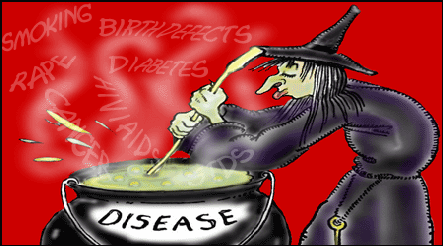From MiddleAgedWoman.com
Myth: Cancer cannot be prevented.
By
Oct 8, 2006 - 12:30:00 AM
(Copied from http://www.CDC.gov)
Fact: Scientists estimate that as many as 50 percent or more of cancer deaths in the United States are caused by social and environmental conditions and unhealthy choices. These conditions and choices can result in an unhealthy diet, obesity, or unhealthy human behaviors such as smoking and physical inactivity. We now know more about how to prevent many cancers including cancers of the lung, cervix, colon, rectum, and skin.
In general, the factors that can help prevent cancer include:
- not using cigarettes or other tobacco products
- avoiding second-hand smoke
- not drinking too much alcohol
- avoiding weight gain and maintaining a healthy weight
- eating five or more daily servings of fruits and vegetables and a low-fat diet
- balancing calories with physical activity
- being physically active
- protecting skin from sunlight
- supporting community efforts to develop a healthy social and physical environment
Breast Cancer
- Researchers estimate that a fourth to a third of breast cancers in postmenopausal women may be due to physical inactivity and overweight/obesity.*
- Mammography is the best available method to detect breast cancer in its earliest, most treatable stageó an average of 1 to 4 years before a woman can feel a lump. Women aged 40 years or older should have a screening mammogram every 1 to 2 years.
- Maintain a healthy weight. Limiting weight gain during childhood and adulthood is likely to reduce the risk of breast cancer. Losing weight if overweight may also reduce risk.
- Regular physical activity is likely to reduce the risk of breast cancer.
- Community efforts to increase physical activity, such as school-based physical education programs and creation of walking trails, can contribute to increased physical activity in your community.
Cervical Cancer
- Cervical cancer can usually be prevented if women are screened regularly at least every three years with a test called the Pap test. The Pap test can find abnormal cells in the cervix. These cells may, over time, turn into cancer, and could take many years to happen. If the results of a Pap test show there are abnormal cells that could become cancerous, a woman can be treated. In most cases, this treatment prevents cervical cancer from developing.
- Pap tests can also find cervical cancer early. When it is found early, the chance of being cured is very high. When it is found early and treated, cervical cancer is highly curable. The most important thing you can do to avoid getting cervical cancer is to have regular Pap tests.
- Abnormal cells in the cervix and cervical cancer don't always cause symptoms, especially at first. That's why getting tested for cervical cancer is important, even if there are no symptoms.
- Community efforts to increase access to and use of cancer screening can lead to greater cancer screening in your community.
Colorectal Cancer
- If you're 50 or older, getting a screening test for colorectal cancer could save your life.
- Colorectal cancer usually starts from polyps in the colon or rectum. A polyp is a growth that shouldn't be there. Over time, some polyps can turn into cancer.
- Screening tests can find polyps, so they can be removed before they turn into cancer. Screening tests can also find colorectal cancer early. When it is found early, the chance of being cured is good.
- Researchers estimate that a fourth to a third of colorectal cancer may be due to physical inactivity and overweight/obesity.*
- Maintain a healthy weight. Limiting weight gain during childhood and adulthood is likely to reduce risk of colorectal cancer and losing weight if overweight may reduce risk.
- Regular physical activity is likely to reduce the risk of colorectal cancer.
- Community efforts to increase physical activity, such as school-based physical education programs and creation of walking trails, can contribute to increased activity in your community. Community efforts to increase access to and use of cancer screening can lead to greater cancer screening in your community.
Lung Cancer
- Avoiding tobacco use is the single most important step Americans can take to reduce the cancer burden in this country.
- Secondhand smoke is associated with an increased risk for lung cancer and coronary heart disease in nonsmoking adults. Secondhand smoke is a known cancer-causing agent.
- Quitting smoking has immediate as well as long-term benefits, reducing risks for diseases caused by smoking and improving health in general.
- Community efforts to limit smoking, such as indoor smoking policies and cigarette taxes, can help reduce smoking and exposure to secondhand smoke.
Skin Cancer
- Exposure to the sun's ultraviolet rays appears to be the most important environmental factor involved in the development of skin cancer. When used consistently, sun-protective practices can prevent skin cancer.
- Although anyone can develop skin cancer, some people are at particular risk, including those with light skin color, hair color, or eye color; family history of skin cancer; personal history of skin cancer; chronic exposure to the sun; history of sunburns early in life; certain types of moles or a large number of moles; and freckles, which indicate sun sensitivity and sun damage.
- Protect your skin from the sun, by choosing five sun protection options: seek shade, cover up, get a hat, wear sunglasses, and rub on sunscreen.
(Copied from http://www.CDC.gov)
© Copyright by
MiddleAgedWoman.com
